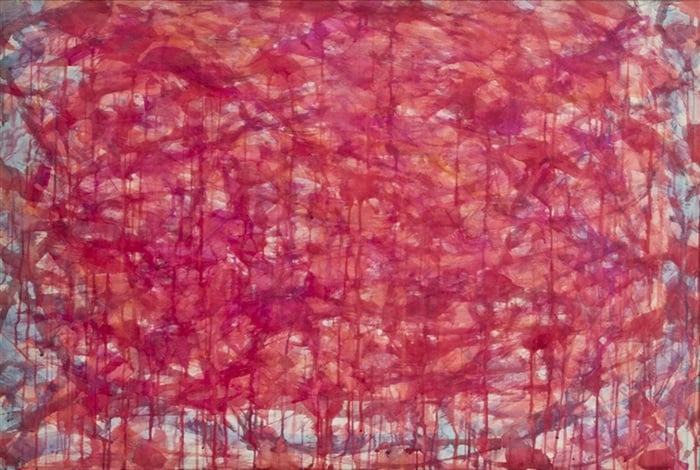
Abstract Expressionist and action painter Norman Bluhm lived the life of an globe-trotting artist—from Chicago to Paris to New York—as he engaged with the art of the time, deliberately placing himself and his work within the larger context of art history. Despite what was richly prolific and celebrated life, why haven’t you heard of him?
A staunch idealist now considered a quintessential “painter’s painter,” Bluhm refused to compromise as tastes shifted, sticking to his guns with a style that art audiences saw as retrograde. Now, over a decade after his death, perhaps we can revisit this singular oeuvre with more objectivity, and appreciate his impact on American art.
Bluhm grew up in Chicago in relatively humble circumstances but excelled academically, going on to study architecture at the Armour (now Illinois) Institute of Technology under Mies van der Rohe at the tender age of 16. During his studies at the Institute, he would spend time in the presence of landmark architects such as Frank Lloyd Wright, and developed a fascination for the Bauhaus school.
After being drafted in to the US Air Force to fight in the Second World War, Bluhm returned to the United States severely injured and emotionally devastated. His brother, who was also joined the Air Force, had lost his life during battle in Germany. Soon after he had returned and recovered, Bluhm would give up his architectural studies before leaving for Italy to devote himself to studying fine art at the Academia de Belle Arte in Florence.
“[I thought] maybe, I’ll do a Mies-type garage one day, or a Mies-type drug store; but I’d be nothing but a little Mies because I somehow didn’t feel even any individual arrogance about architecture,” he said in his oral history interview with the Smithsonian in 1969. “I admired it, I loved it. I still do. I like architecture. But I felt I would never make even an interesting architect.“
Norman Bluhm, Untitled (1960). Courtesy of Washburn Gallery
After completing his studies in Italy, Bluhm would move to Paris to attend the famed Ecole des Beaux Arts. During his time living in the French capital, Bluhm began to mingle with avant-garde artists like Paul Eluard, Pablo Picasso, and Alberto Giacometti, even appearing in Jean Cocteau’s landmark 1969 film Orphée. In this way, he experienced painting directly from not just the great artists of the past in Parisian museums, but also from the contemporary artists breaking new ground in the medium. Bluhm would also meet his first wife before returning to the United States in the mid-1950s.
Norman Bluhm, Untitled (1966). Courtesy of Galerie Ziegler SA.
It was during this time that his paintings became increasingly abstract and active, utilizing frenetic splashes and drips that were inspired by the new American Abstract Expressionism popularized by artists like Willem de Kooning. Throughout his career, Bluhm looked to the history of art and mined his extensive knowledge of it to create deeply personal work with a passion for exploring the limits of painting.
One of his favorite subjects was the nude, of which he painted many in his signature gestural style. His aesthetic and technique continued to evolve throughout his life, rejecting the idea of working within the zeitgeist to sell paintings. By the 1960s, Pop Art was dominating the conversation, but Bluhm found it dull. He was resolutely more concerned with exploring his relationship with paint, citing Impressionist Jean-Baptiste-Camille Corot and Realist painter Gustave Courbet as his heroes.
“Not in painting, in their style or in the style of their period, but in the spiritual and the light of them and certain crystal elements which Corot or Courbet each different in another way. I was very involved in them. And I tried to paint big landscapes with this kind of feeling about light.”
Norman Bluhm, Untitled (A7010) (1976). Courtesy of Findlay Galleries.
His gestures loosened in the 1960s, as he produced sparse gestural works with perhaps one or two large splashes of paint across the canvas. Bluhm’s practice changed further in the following decade as he increased his scale, rendering huge abstract works with more of a formal quality than his previous paintings. By the 1980s, his palette had intensified, with colors becoming brighter and more saturated in huge, ambitious diptych and triptychs. It was this series that saw the artist gain a sudden surge in popularity, just before his death in 1999.
Norman Bluhm, Byzantine Windows (1992). Courtesy of Los Angeles Modern Auctions.
These paintings, containing overt religious references and imagery, represented a major departure from his earlier work. Although still wildly gestural, they are more decidedly more representational and often feature hints of the nudes from his earliest canvases.
Despite how revered Bluhm’s work is among other painters, his oeuvre is not widely known—despite being prominently featured in museum collections around the world, notably including The Museum of Modern Art in New York and MOCA in Los Angeles. The retrospective “The Late Paintings of Norman Bluhm,” held at the Station Museum of Contemporary Art in Houston in 2007, renewed interest in this landmark American artist. Perhaps with hindsight, more people will pick up on the talent of an artist who refused to play the commercial art game. Until then, enjoy being one of the few that knows Norman Bluhm by name.